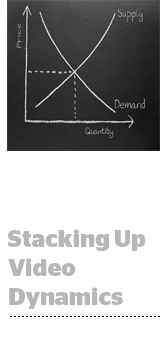 Digital automation may increase the volume of video ads initially, but improvements in targeting and cross-screen frequency caps will drive more relevancy while ultimately reducing the overall ad load.
Digital automation may increase the volume of video ads initially, but improvements in targeting and cross-screen frequency caps will drive more relevancy while ultimately reducing the overall ad load.
It’s no surprise that data and technology are upending the upfront TV buy.
Following a two-year slump in advance upfront commitments, Forrester expects advertisers to combine scatter, spot and digital video buys, in order to increase flexibility in their television campaigns.
As a result, digital video ad spend will grow 21% annually, Forrester predicts in a new report about the video ad ecosystem, released Wednesday. Conversely, broadcast ad spend declined 10% year over year while cable spend fell 3% in the second quarter, based on a Standard Media Index survey of global media agencies representing 80% of national ad spend.
Despite projected growth in digital video, marketers remain confounded by the number of point solutions in the video ecosystem, many of which mimic functionalities in the broader digital tech stacks, Forrester found.
While broadcasters and publishers use video sell-side platforms like LiveRail, FreeWheel and Videoplaza (which now operates under brand name Ooyala, its acquiring company), marketers use buying platforms like TubeMogul and Videology. Meanwhile, vendors like Canoe and clypd connect diverse delivery systems like video on demand, cable and over-the-top services.
These tools are uniquely specialized and are often disparate from the display ad solutions marketers already use, said Jim Nail, principal analyst and author of the Forrester report.
But consolidation is underway. For some, it meant buying into the video marketplace. For instance, Yahoo acquired BrightRoll and AOL bought Adap.tv, which Verizon now owns. Meanwhile, digital exchanges are investing in video – consider Rubicon Project, which struck a video inventory deal with video ad platform Virool.
And others, like video DSP TubeMogul, still focus squarely on the buy side but have expanded their capabilities by recently rolling out display, citing marketer demand for greater bundling and streamlining of inventory. And while Tremor Video initially focused on the buy side, it rolled out an SSP last year.
“It would not surprise me if, in a few years, there is not a video DSP or a digital DSP – there is just an omni DSP,” Nail said. “In TV, there are certain dayparts that are primary brand-building opportunities, and there are others that are reminder opportunities. Banners are a classic ‘reminder’ opportunity … so being able to have in one platform that ability to control messaging around exposure down to the individual level will [help] marketers.”
As the video ecosystem matures, ad spend might decline, Nail predicted, due to the technology advancements allowing marketers to achieve greater effectiveness and waste less by consolidating their buys or improving analysis cross-screen.
Forrester predicts that media companies will offset reduced ad loads with higher pricing, unique customization and better targeting. So, while there could be a reduction in the overall ad load, the ads that consumers do see could benefit from improved relevancy.
Another prediction? Expect disruption from another important constituent in the digital video ecosystem – the trusty workflow, billing and trafficking tool, such as systems like Mediaocean, Operative and STRATA, which often cut deals directly with media agencies or publishers.
Particularly with the shift to “programmatic TV,” these tools are becoming more prevalent as players such as Mediaocean now integrate directly with ad servers like Facebook’s Atlas and buying platforms like Videology, as well as comScore for audience data.
Nail said the battle of the next few years could be between traditional DSPs, which historically have owned the execution layer, and the workflow provider, which maintains the role of systems integrator, in addition to a reporting and ad-serving tool.
If the video DSPs master cross-platform/device reach and frequency analysis, which “Mediaocean has done for TV for decades,” Nail said, “they’ll be in the pole position.”













